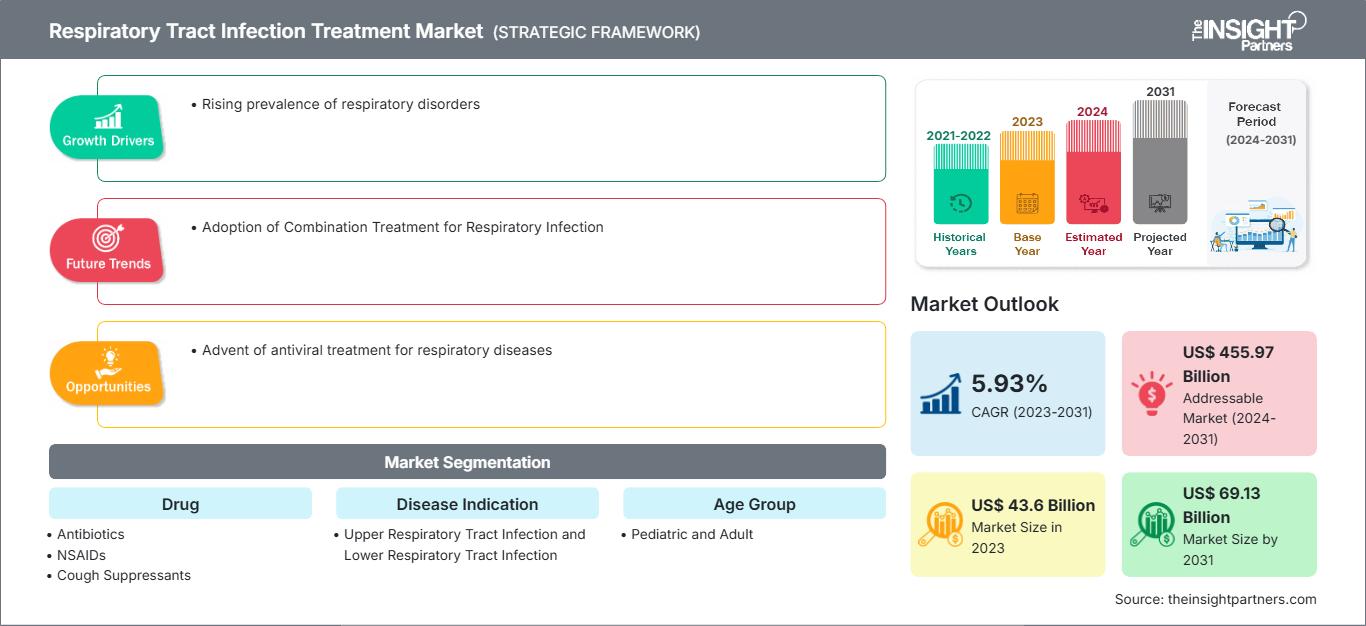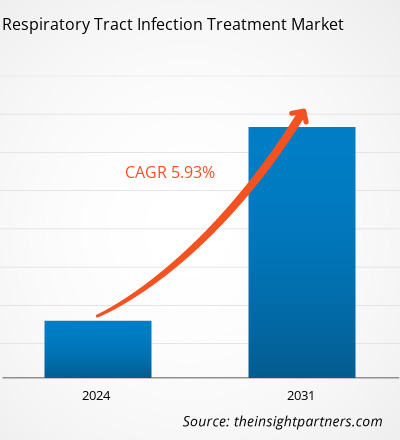呼吸器感染症治療市場規模は、2023年の436億米ドルから2031年には691.3億米ドルに達すると予想され、2023年から2031年にかけて5.93%のCAGRを記録すると見込まれています。
呼吸器感染症(RTI)は、副鼻腔、喉、気道、または肺の感染症です。世界の呼吸器感染症治療市場レポートでは、市場を牽引する主な要因に焦点を当て、主要企業の動向を描いています。市場の成長を牽引する主な要因には、世界的な呼吸器感染症の罹患率の上昇、呼吸器感染症および呼吸器感染症に関連するさまざまな治療薬に関する意識の高まり、呼吸器感染症治療に関連する臨床試験の増加などが挙げられます。しかし、呼吸器治療薬および呼吸器感染症薬に関連する副作用に焦点を当てた研究の不足が、市場の成長を妨げています。さらに、抗ウイルス治療の登場により、今後数年間で呼吸器感染症治療市場の新たな世界的なトレンドがもたらされると予想されています。
成長の原動力と制約:
高齢者層における呼吸器疾患診断の需要の高まり
高齢者人口が世界的に増加するにつれて、今後数年間で呼吸器疾患の診断の需要が増加すると予想されています。たとえば、2021年11月にBritish Journal of Pharmacologyに掲載された記事によると、英国の人口の約1%が毎年市中肺炎(CAP)と診断されています。症例の約70%は65歳以上で発生し、この年齢層の30日死亡率は約20%です。このように、高齢化の進展とCAPなどの疾患の発症率の増加は、呼吸器疾患治療の需要を押し上げ、市場全体の成長を後押しすると予想されます。
この分野における継続的な研究開発により、今後数年間の市場成長にプラスの影響を与える様々な診断検査や診断手順が開発されています。革新的な診断方法は、予測期間中に市場発展の好機となることが期待されます。しかしながら、呼吸器感染症治療薬に関する研究の不足と副作用は、世界の呼吸器感染症治療市場の成長を制限すると予想されます。
要件に合わせてレポートをカスタマイズ
レポートの一部、国レベルの分析、Excelデータパックなどを含め、スタートアップ&大学向けに特別オファーや割引もご利用いただけます(無償)
呼吸器感染症治療市場: 戦略的洞察

- このレポートの主要な市場動向を入手してください。この無料サンプルには、市場動向から見積もりや予測に至るまでのデータ分析が含まれます。
レポートの一部、国レベルの分析、Excelデータパックなどを含め、スタートアップ&大学向けに特別オファーや割引もご利用いただけます(無償)
呼吸器感染症治療市場: 戦略的洞察

- このレポートの主要な市場動向を入手してください。この無料サンプルには、市場動向から見積もりや予測に至るまでのデータ分析が含まれます。
レポートのセグメンテーションと範囲:
世界の呼吸器感染症治療市場分析は、薬物疾患適応症、投与経路、年齢層、流通チャネルという以下のセグメントを考慮して実施されています。薬物に基づいて、市場は抗生物質、NSAIDs、鎮咳剤、鼻づまり緩和剤などに分類されています。疾患適応症別では、世界の呼吸器感染症治療市場は上気道感染症と下気道感染症に分類されています。投与経路の点では、市場は経口と非経口に区別されています。年齢層に基づいて、市場は小児と成人に分類されています。流通チャネルに基づいて、世界の呼吸器感染症治療市場は、病院薬局、オンライン薬局、小売薬局に分類されます。
セグメント分析:
医薬品別では、抗生物質セグメントが2023年に世界の呼吸器感染症治療市場で最大のシェアを占めました。このセグメントは、2023年から2031年にかけて最高のCAGRを記録すると予想されています。呼吸器感染症には、気管支炎、肺炎、副鼻腔炎など、細菌性病原体によって引き起こされることが多いさまざまな疾患が含まれます。抗生物質はこれらの有害な細菌を標的として排除し、炎症を軽減し、回復を早めます。呼吸器感染症に一般的に処方される抗生物質には、ペニシリン、セファロスポリン、マクロライド、フルオロキノロン、テトラサイクリンなどがあり、それぞれ独自の作用機序と細菌標的があります。
疾患適応症に基づくと、下気道感染症セグメントは2023年に大きな市場シェアを占めました。さらに、2023年から2031年にかけて高いCAGRを記録すると予想されています。下気道感染症(LRTI)は、肺や気管支に影響を与える感染症で、通常は細菌、ウイルス、真菌などの病原体によって引き起こされます。肺炎、気管支炎、細気管支炎などの状態は、通常、湿性咳嗽、胸部不快感、息切れ、発熱などの症状を呈し、LRTIの範囲に分類されます。重度のLRTIである肺炎は、肺組織の炎症と感染を伴い、肺の硬化(肺の一部の領域または臓器全体)とガス交換障害を引き起こします。
投与経路別に見ると、経口セグメントが世界の呼吸器感染症治療市場で大きなシェアを占めており、このセグメントは2023~2031年に高いCAGRを記録すると予想されています。アモキシシリン、アジスロマイシン、ドキシサイクリンなどの経口抗生物質は、呼吸器感染症を引き起こす細菌性病原体と戦うために頻繁に処方されます。抗生物質に加えて、経口コルチコステロイドは、重度の喘息または慢性閉塞性肺疾患(COPD)の増悪時の炎症を軽減する可能性があります。オセルタミビルなどの経口抗ウイルス薬は、インフルエンザなどのウイルス性呼吸器感染症の治療に利用されます。経口投与の一般的な利点には、投与が容易であること、患者の順守が図られること、薬剤の全身分布が挙げられます。
年齢層別では、2023年に成人セグメントが世界の呼吸器感染症治療市場で大きなシェアを占めました。小児科セグメントは、2023~2031年に高いCAGRを記録すると予想されています。小児の呼吸器感染症の早期診断と治療の重要性に関する認識や、治療に使用される呼吸器デバイスの進歩などの要因により、新しくより効果的な治療オプションが開発されています。さらに、予防医療への関心の高まりも、小児科セグメントの市場成長に貢献しています。
流通チャネル別では、病院薬局セグメントが2023~2031年に大きな市場シェアを占めると予想されています。病院薬局は医療システムの重要な構成要素として機能しています。特に、静脈内または筋肉内投与を必要とする急性および重症の呼吸器感染症の管理において重要な役割を果たします。これらの薬局は、抗生物質、抗ウイルス薬、コルチコステロイド、その他の呼吸器感染症治療薬の調達、保管、調剤を行うとともに、病院の入院患者および外来患者に安全かつ迅速に薬を届けることを担っています。
呼吸器感染症治療呼吸器感染症治療市場の地域別分析
呼吸器感染症治療市場の地域別分析
The Insight Partnersのアナリストは、予測期間を通じて呼吸器感染症治療市場に影響を与える地域的な傾向と要因を詳細に解説しています。このセクションでは、北米、ヨーロッパ、アジア太平洋、中東・アフリカ、中南米における呼吸器感染症治療市場のセグメントと地域についても解説しています。
呼吸器感染症治療市場レポートの範囲
| レポート属性 | 詳細 |
|---|---|
| の市場規模 2023 | US$ 43.6 Billion |
| 市場規模別 2031 | US$ 69.13 Billion |
| 世界的なCAGR (2023 - 2031) | 5.93% |
| 過去データ | 2021-2022 |
| 予測期間 | 2024-2031 |
| 対象セグメント |
By 薬物
|
| 対象地域と国 | 北米
|
| 市場リーダーと主要企業の概要 |
|
呼吸器感染症治療市場におけるプレーヤーの密度:ビジネスダイナミクスへの影響を理解する
呼吸器感染症治療市場は、消費者の嗜好の変化、技術の進歩、製品の利点に対する認知度の高まりといった要因によるエンドユーザーの需要増加に牽引され、急速に成長しています。需要の増加に伴い、企業は製品ラインナップの拡充、消費者ニーズへの対応のための革新、そして新たなトレンドの活用を進めており、これが市場の成長をさらに加速させています。

- 入手 呼吸器感染症治療市場 主要プレーヤーの概要
地域分析:
呼吸器感染症の早期診断と治療の重要性についての国民の意識の高まりは、今後数年間で世界の呼吸器感染症治療市場の成長に貢献する可能性があります。市場は、北米、ヨーロッパ、アジア太平洋、中東およびアフリカ、南米および中米に分割されています。北米は、2023年に世界の呼吸器感染症治療市場で最大のシェアを占めました。北米の市場は、国内の呼吸器感染症の有病率の上昇により、大幅な成長を遂げています。大気汚染、喫煙、混雑した生活環境などの要因が、国内の呼吸器感染症の発生率の高さに寄与しています。呼吸器感染症の罹患率の増加、ヘルスケアに関する意識の高まり、および政府による好ましい取り組みが、世界の呼吸器感染症治療市場の成長を牽引しています。
競合状況と主要企業:
世界の呼吸器感染症治療市場の予測は、関係者が成長戦略を計画するのに役立ちます。Abbott Laboratories、AstraZeneca plc、Alembic Pharmaceuticals Ltd.、Boehringer Ingelheim International GmbH、GlaxoSmithKline plc、Teva Pharmaceutical Industries Ltd、Novartis AG、F. Hoffmann-La Roche AG、Sanofi SA、Merck & Co.、Cipla は、世界の呼吸器感染症治療市場レポートで紹介されている著名な企業です。これらの企業は、急増する消費者需要に対応し、専門ポートフォリオで製品範囲を拡大するために、さまざまな戦略(有機と無機の両方を含む)に重点を置いています。市場の企業が採用している主な戦略には、新技術の導入、既存製品の開発、地理的拡大などがあります。
- 過去2年間の分析、基準年、CAGRによる予測(7年間)
- PEST分析とSWOT分析
- 市場規模価値/数量 - 世界、地域、国
- 業界と競争環境
- Excel データセット
最新レポート
お客様の声
購入理由
- 情報に基づいた意思決定
- 市場動向の理解
- 競合分析
- 顧客インサイト
- 市場予測
- リスク軽減
- 戦略計画
- 投資の正当性
- 新興市場の特定
- マーケティング戦略の強化
- 業務効率の向上
- 規制動向への対応






















 無料サンプルを入手 - 呼吸器感染症治療市場
無料サンプルを入手 - 呼吸器感染症治療市場